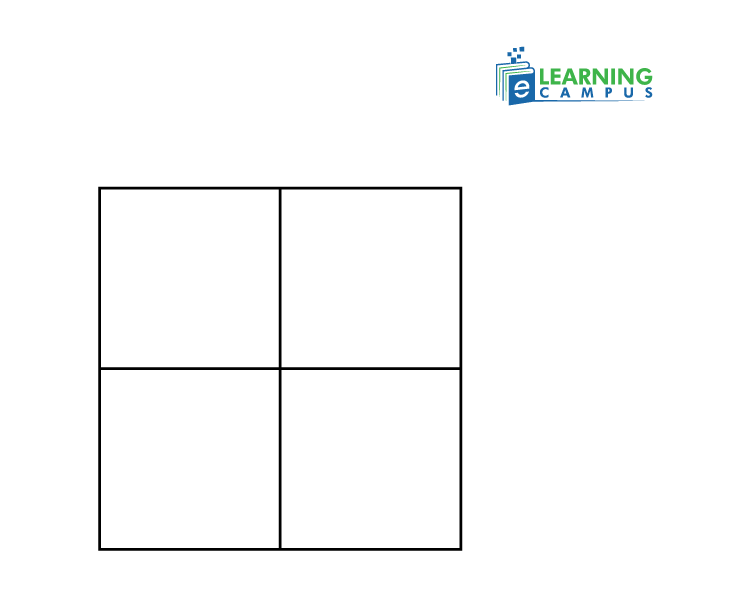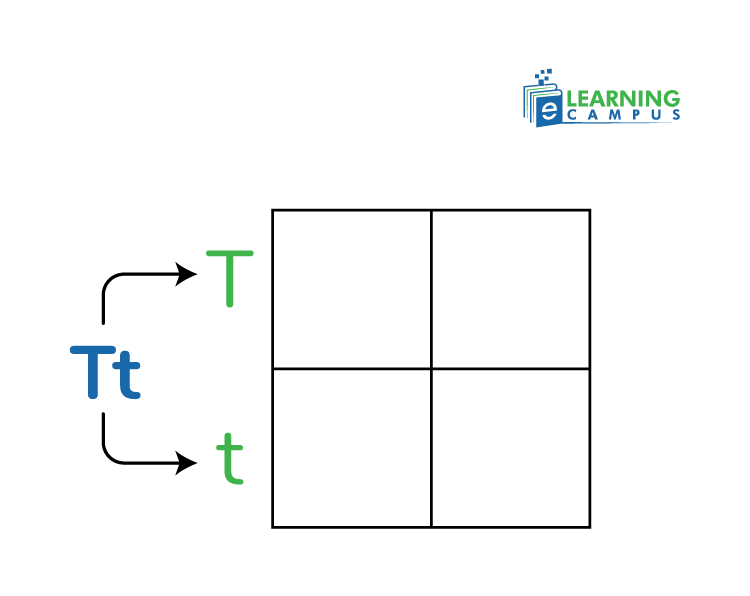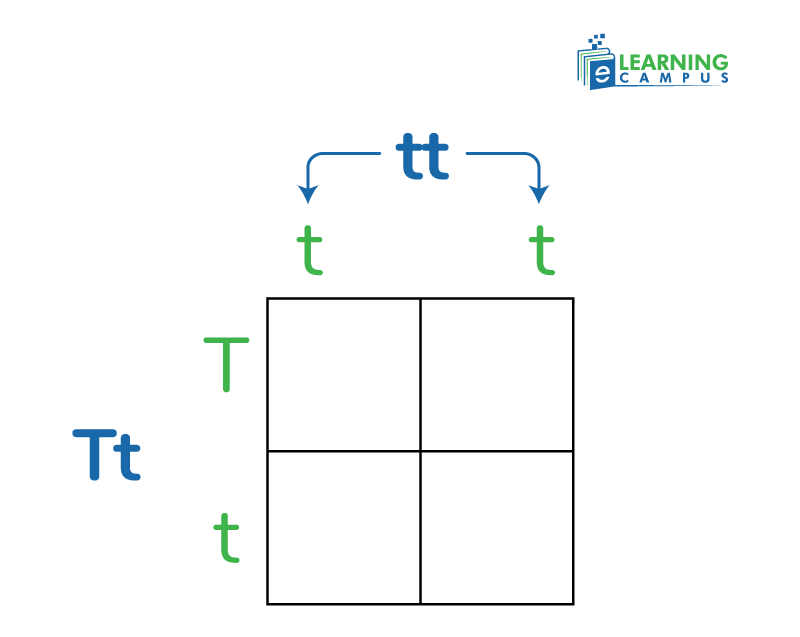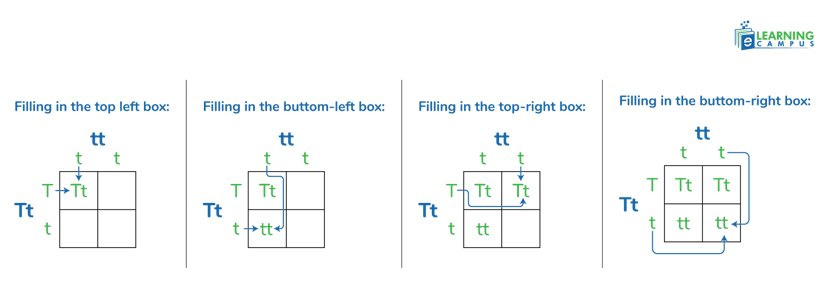Punnett Square Practice

What did you think when you heard ‘Punnett square’ for the first time? A mathematical concept? You may also get confused like other students. A Punnett square is both a biological and a mathematical concept. It is actually a mathematical concept that is used in Biology.
In biology, a Punnett square is used in genetics to predict the probable genotypes and phenotypes of offspring of parents. It helps in predicting the variations and probabilities that occur from cross-breeding.
What is A Punnet Square
Some mathematical concepts are also used in biology. One of them is a Punnett square. It is a grid used in genetics to predict the possible combinations of alleles and the probability of offspring inheriting a particular trait from cross-breeding of parents.
The Punnet square was created by British geneticist Reginald Punnett in the early 1900s. The classification of living organisms makes it easy to predict the offspring's trait probability for each species.
The Key Concepts Used in Punnet Square
The Punnet square deals with the genes and offspring. It is therefore important to understand the related terms used in this process. Without the knowledge of these concepts, the predictability of offspring will be difficult.
The key concepts include;
Allele
An allele is a different version or variant of the same gene. It is found at the same position (locus) on a chromosome. Organisms inherit two alleles for each gene, one from each parent. It determines specific traits such as eye color or flower color. It is represented by a dominant ‘P' allele or a recessive ‘p' allele.
Genotype
The genotype is the genetic makeup of an organism. It is represented by the combination of alleles, such as PP, Pp, or pp.
Phenotype
The phenotype is an observable physical characteristic that emerges from the genotype, such as purple or white flowers.
Dominant Allele
A dominant allele is an allele that is expressed in the phenotype, even if only one copy is present, such as a capital letter.
Recessive Allele
A recessive allele is an allele that is only expressed in the phenotype when two copies are present and the dominant allele is absent, such as a lowercase letter.
How to Draw a Punnet Square
A Punnet square is easy to draw. To create a punnet square, follow these steps:
- Draw the Grid: Create a square grid. For a single trait, use a 2x2 grid (four squares). For two traits, use a 4x4 grid (sixteen squares).
- Label the Grid: Write the alleles from one parent across the top row of the grid. Write the alleles from the other parent down the left side of the grid.
- Fill the Boxes: Combine the allele from the top and the allele from the left side to fill each square in the grid. The dominant allele is conventionally written first if there are both a dominant and a recessive allele.
How to Use The Punnet Square
A Punnett square is used to predict the offspring trait. Students find it difficult to use it. We will explain the process of using a Punnett square in a step-by-step manner. This method helps figure out the possible genetic outcomes when two organisms, such as plants or animals, reproduce.
Figure Out the Parents’ Genotypes
Genotype is the genetic code for a trait. Identify the specific gene alleles for each parent. These are written in letters "Tt" or "tt". For example, if a parent has the genotype Tt, they have one dominant (T) and one recessive (t) allele.
Write Down the Cross
Write the genotypes of the two parents, like Tt x tt or Bb x bb.
Draw a Punnett Square
A Punnett square is a simple grid used to predict offspring genotypes. Draw a 2x2 grid (4 boxes total) for a single-trait cross.

Separate Alleles into Gametes
Split the Parents’ Alleles and Place Them on the Punnett Square. Each parent contributes one allele to the offspring. It is represented by a letter. Here, we will use Ttxtt.
- Take the genotype of the first parent ‘Tt’ and split the letters. Put one letter on the left of each row of the Punnett square. For ‘Tt’, put "T" by the top row and "t" by the bottom row.

- Take the genotype of the second parent ‘tt’ and split the letters. Put one letter above each column. For ‘tt’, put ‘t’ above the first column and ‘t’ above the second column, since both alleles are the same.

Fill in the Punnett Square
To find the possible offspring genotypes, combine the alleles from the rows and columns. For each box, take the letter from the left (row) and the letter from the top (column).
Example for ‘Tt x tt’
- Top-left box: ‘T’ (row) + ‘t’ (column) = ‘Tt’.
- Top-right box: ‘T’ (row) + ‘t’ (column) = ‘Tt’.
- Bottom-left box: ‘t’ (row) + ‘t’ (column) = ‘tt’.
- Bottom-right box: ‘t’ (row) + ‘t’ (column) = ‘tt’.
Each box now shows a possible genotype for the offspring.

Summarize the Results
Look at the genotypes in the Punnett square and count how many of each type you have. Use them to calculate the probability or percentage of offspring with specific genotypes and phenotypes.
Translate the genotypes into phenotypes. It predicts what the offspring look like.
- Tt = tall because T is dominant.
- tt = short. It is recessive; it only shows if no T is present.
Example summary for Tt x tt
- Genotypes: 2 out of 4 boxes are Tt (50%), and 2 out of 4 are tt (50%).
- Phenotypes: 50% tall (Tt) and 50% short (tt).
So,
- Parents: Tt (tall) x tt (short).
- Offspring Genotypes: 50% Tt, 50% tt.
- Offspring Phenotypes: 50% tall, 50% short.
Types of Genetic Crosses Used in Punnet Squares
There are three main genetic crosses that are used in punnet squares to predict the trait of offspring. They include Monohybrid, Dihybrid, and Trihybrid Crosses.
Monohybrid Cross
A monohybrid cross is a genetic cross between two individuals that differ in only one specific trait, such as flower color or seed shape. This results in a predictable phenotypic ratio of approximately 3:1 (dominant to recessive) in the offspring of two heterozygous parents, which can be predicted using a Punnett square.
Dihybrid Cross
A dihybrid cross is a genetic experiment crossing two individuals that are heterozygous (have two different alleles) for two traits, like pea plant seed color and shape.
It shows how traits are inherited and follows Mendel's Law of Independent Assortment, where traits are passed on separately. This results in a 9:3:3:1 ratio of trait combinations in the offspring. A Punnett square is used to predict the possible genetic and physical outcomes.
Punnet Square Practice Worksheet
As we learned about the Punnet square and how to use it. The Punnett square practice worksheets can help students understand the genetics concepts. It enhances problem-solving skills and provides hands-on experience with genetic inheritance patterns.
These worksheets help learners visualize and understand the probability of offspring inheriting specific alleles and traits from their parents. They serve as a valuable tool for both learning and assessment in biology.
The punnet square questions are usually asked in college admission tests such as the SAT. You can prepare for the SAT online with expert tutors.
How The Punnett Square Worksheet Practice Can Help You
The punnet square practice worksheet provides you with an opportunity to practice the problems that involve the probability of inheritance. Here is how it can help you.
Concept Reinforcement
Worksheets provide repeated practice with Punnett squares, which helps solidify understanding of fundamental genetics principles like dominant and recessive traits, homozygosity, and heterozygosity.
Hands-On Learning
The graphical nature of Punnett squares offers a concrete, visual method for students to engage with abstract genetic concepts. It makes them easier to grasp.
Skill Development
Completing practice problems develops critical thinking and problem-solving skills as students learn to analyze genetic crosses and predict the outcomes of breeding events.
Application of Knowledge
Worksheets encourage students to apply their knowledge to practical scenarios, helping them understand how theoretical concepts relate to real-world genetics.
Assessment and Feedback
Worksheets with answer keys enable students to review their work and identify any mistakes immediately. It helps your online science tutor assess and identify areas needing further instruction.
Foundation for Advanced Topics
Mastering Punnett squares provides a strong foundation for more complex topics in genetics, such as dihybrid crosses and population genetics.
You can download the Punnett square practice worksheet with an answer key in PDF.
Download Worksheet
Blood Type Punnett Square Practice
Blood type Punnett square practice involves using a Punnett square to understand ABO blood type inheritance. It involves identifying the parents' blood type alleles, constructing the Punnett square, filling it with possible allele combinations, and analyzing the results. Doing this, you can determine the probability of different blood types for their children.
You can practice a Punnett square for blood types in a PDF. You can download the worksheet in PDF.
Download Worksheet
Sex Linked Punnett Square Practice
A Sex-Linked Punnett Square is a genetic tool that is used to predict the inheritance of traits carried on the sex chromosomes (X and Y chromosomes). Unlike standard Punnett squares, sex-linked Punnett squares represent alleles on these sex chromosomes. Males only have one X chromosome, and females have two.
It helps to determine the probabilities of offspring inheriting sex-linked traits or disorders, like color blindness or hemophilia.
Practice the sex related Punnett square worksheet. You can download the printable Punnett square practice worksheet answer key in PDF.
Download Worksheet
Conclusion
A Punnett square is a grid used in genetics to predict the genotypic and phenotypic outcomes of a genetic cross between two parents by illustrating all possible combinations of their alleles. Practicing it can help you find the traits of offspring.
Learn Biology Online With Expert Tutors
Are you stressed about your biology exams and don’t know how to prepare? Don’t worry. We have a solution for you. We have online Science tutors to make science subjects easy and understandable for you. You will get targeted preparation for your exams.
